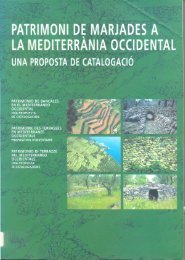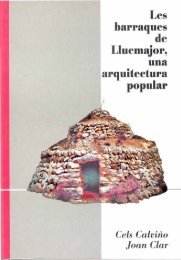La pedra en sec. Materials, eines i tècniques tradicionals a les illes ...
La pedra en sec. Materials, eines i tècniques tradicionals a les illes ...
La pedra en sec. Materials, eines i tècniques tradicionals a les illes ...
Create successful ePaper yourself
Turn your PDF publications into a flip-book with our unique Google optimized e-Paper software.
*** *<br />
* * ** 6 DRYSTONE MASONRY STRUCTURES<br />
DRYSTONE MASONRY<br />
STRUCTURES<br />
Agricultural activity in Majorca has<br />
traditionally be<strong>en</strong> connected with the<br />
pres<strong>en</strong>ce of drystone masonry structures<br />
which have left their mark on the<br />
island's landscape in aspects as<br />
diverse as the property structure, arable<br />
and livestock tasks and the use<br />
made of woods.<br />
Drystone masonry structures are<br />
very varied by type and meet differ<strong>en</strong>t<br />
needs. Boundary walls, living quarters<br />
for human beings and for animals, terraced<br />
fields, water resource structures,<br />
roads and structures used for<br />
pre-industrial extractive activities as<br />
well as the use of woods (charcoal<br />
production, building materials, hunting,<br />
etc.) all stand out. Drystone<br />
masonry work is also to be se<strong>en</strong> in the<br />
paving of courtyards and drives at<br />
country houses and the base platforms<br />
of flour windmills.<br />
<strong>La</strong>ndscapes marked by the pres<strong>en</strong>ce<br />
of drystone masonry can be found<br />
throughout Majorca although it is<br />
most widespread in two areas. The<br />
defining features on the flat landscapes<br />
of the south and east of the island<br />
are boundary walls, huts and water<br />
managem<strong>en</strong>t facilities. In the "Serra<br />
de Tramuntana" the most characteristic<br />
features are terraced fields with a<br />
significant paved road network and<br />
excess water control constructions.<br />
The large-scale developm<strong>en</strong>t and<br />
variety of constructions can only be<br />
attributed to a conjunction of physical<br />
and historical circumstances. The<br />
most important physical factor is the<br />
predominance of limestone rock<br />
which is both pl<strong>en</strong>tiful and of a high<br />
quality. This has <strong>en</strong>abled the building<br />
of complex structures, whilst other<br />
<strong>les</strong>s abundant rocks have <strong>en</strong>riched<br />
the variety of types.<br />
The wild relief combined with the<br />
chances of heavy rain made it necessary<br />
to build structures geared<br />
towards prev<strong>en</strong>ting erosion and flooding<br />
and towards making it possible<br />
to farm the slopes (terraced fields)<br />
(marjades). Moreover the summer<br />
drought also created a need to build<br />
water collection, supply and storage<br />
facilities.<br />
As for historical factors, the exist<strong>en</strong>ce<br />
of drystone masonry constructions<br />
can be found in the docum<strong>en</strong>ts<br />
dating from the 13th and 14th c<strong>en</strong>turies<br />
m<strong>en</strong>tioned above, although the<br />
major developm<strong>en</strong>ts took place in<br />
later c<strong>en</strong>turies. In g<strong>en</strong>eral terms, the<br />
expansion of agricultural land and of<br />
drystone masonry continued up until<br />
the start of the 20th c<strong>en</strong>tury including<br />
a number of periods wh<strong>en</strong> growth<br />
was faster. This tilling of new land over<br />
the c<strong>en</strong>turies led to the creation of<br />
boundary walls, terraced fields, temporary<br />
living quarters, etc.<br />
The progressive abandonm<strong>en</strong>t of<br />
farming land giving a marginal yield<br />
and of many other economic activities<br />
involving drystone masonry construction<br />
(lime and charcoal manufacture,<br />
etc.) began in the first decades of the<br />
20th c<strong>en</strong>tury. The process speeded<br />
up wh<strong>en</strong> mass tourism reached the<br />
island in the 1960's. This tourism<br />
affected all parts of the island and the<br />
traditional rural crafts which are at<br />
pres<strong>en</strong>t undergoing a growing urbanisation<br />
process as a result of the<br />
expansion of resid<strong>en</strong>tial tourism. •




